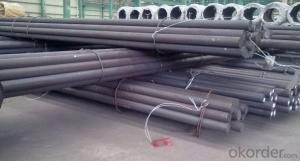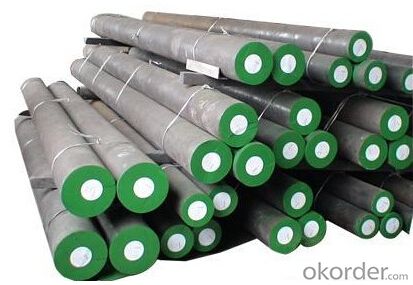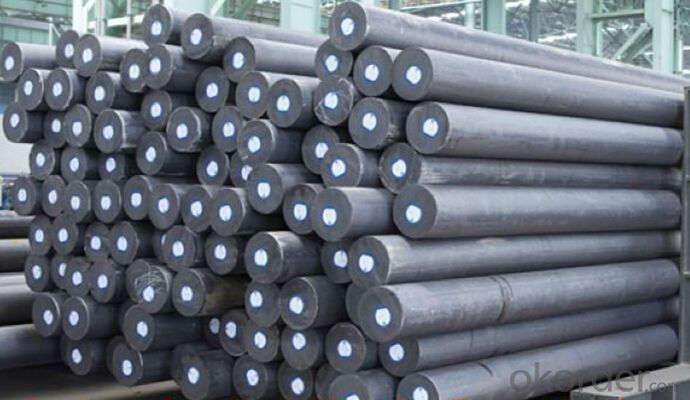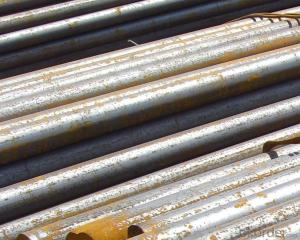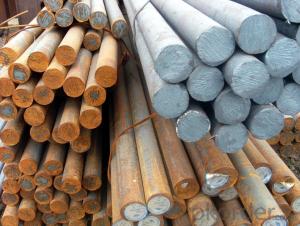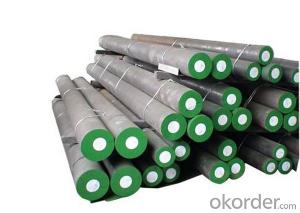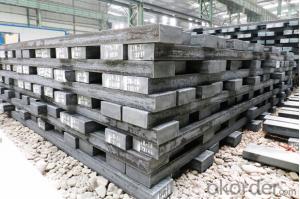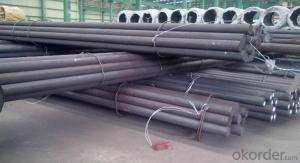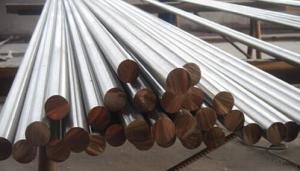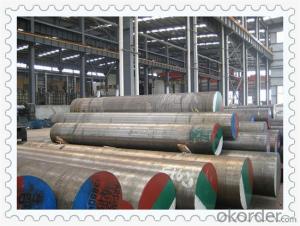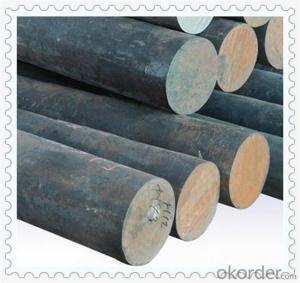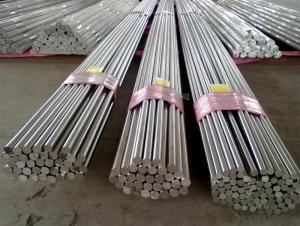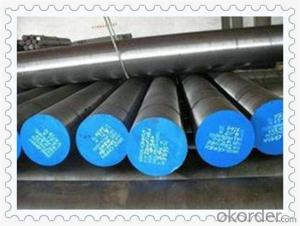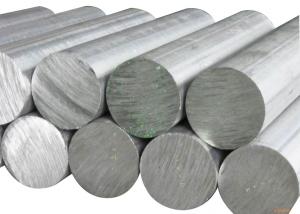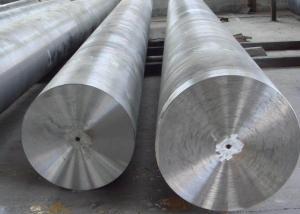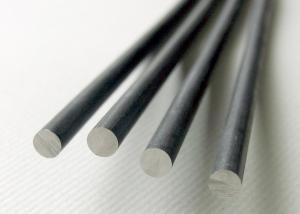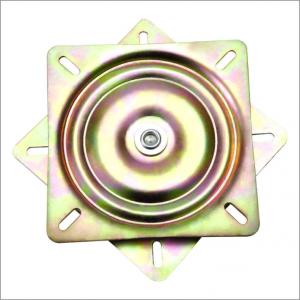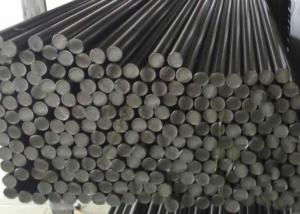Grade SAE1045 CNBM Carbon Steel Round Bar
- Loading Port:
- Shanghai
- Payment Terms:
- TT OR LC
- Min Order Qty:
- 3 m.t
- Supply Capability:
- 10000 m.t/month
OKorder Service Pledge
OKorder Financial Service
You Might Also Like
Specification
Specifications of Round Bar
Material | 1045 | Round bar | Dia(mm) | 16-300 |
Process | EAF + LF + VD + Forged + Heat Treatment (optional) | Length (mm) | Max 12000 | |
Heat treatment | Normalized / Annealed / Quenched / tempered | Flat bar | Thickness(mm) | 8-500 |
Delivery condition | Hot forged +Rough machined (black surface after Q/T)+ Turned (optional) | Width(mm) | 70-200 | |
Test | Ultrasonic test according to SEP 1921-84 D/d | Length (mm) | Max 12000 | |
Chemical Compostion
C | Si | Mn | S | P | Cr | Ni | Mo |
0.42~0.50 | ≤0.40 | 0.50~0.80 | ≤0.045 | ≤0.045 | ≤0.40 | ≤0.40 | ≤0.10 |
Our Featured Products
Alloy steel / Bearing steel// Spring steel/ Cr- mo steel
GB 20Cr/ 40Cr / 42CrMo / 35CrMo/ 20CrMn/GCr15/30CrMnTi…
ASTM 5120 /5140 / 4140/ 4135/ 5152/52100…
JIS SCr420H/ SCr440/ SCM3/ SUP9/SUJ2…
Carbon steel: Carbon tool steel /Carbon Structural Steel
GB 20/ 35 /45/…
ASTM 1020/ 1030/1045…
JIS S20C/ S30C / S45C…
Usage and Applications of Round Bar
1. Chinese standard steel bar is often used where large amounts of steel need to be formed, for example as structural steel.
2. And we can use this kind of product on the performance of the mechanical parts if the demand is not very high.
3. Steel round bar is used in construction and a large number of architectural and engineering structures.
Packaging & Delivery of Round Bar
Packaging Detail: All goods are packed in bundle with steel strips and shipped by break bulk vessel or container (depend on target market and different ports)
Delivery Detail: 15~45 days
Trade terms: FOB, CFR, CIF
Weight: Theprice invoicing on theoretical weight basis or actual weight basis depends on customer’s request.
Shipment: The shipment of bulk break or container is depends on customer’s request and the situation of the port of destination.
Documents given: Full set of original clean on board bill of lading; Original signed commercial invoice; Original packing list; Policy of insurance; Certificate of origin and what the target market needs.
FAQ:
Q1: Why buy Materials & Equipment from OKorder.com?
A1: All products offered byOKorder.com are carefully selected from China's most reliable manufacturing enterprises. Through its ISO certifications, OKorder.com adheres to the highest standards and a commitment to supply chain safety and customer satisfaction.
Q2: How do we guarantee the quality of our products?
A2: We have established an advanced quality management system which conducts strict quality tests at every step, from raw materials to the final product. At the same time, we provide extensive follow-up service assurances as required.
Q3: How soon can we receive the product after purchase?
A3: Within three days of placing an order, we will begin production. The specific shipping date is dependent upon international and government factors, but is typically 7 to 10 workdays.
Q4: What makes stainless steel stainless?
A4: Stainless steel must contain at least 10.5 % chromium. It is this element that reacts with the oxygen in the air to form a complex chrome-oxide surface layer that is invisible but strong enough to prevent further oxygen from "staining" (rusting) the surface. Higher levels of chromium and the addition of other alloying elements such as nickel and molybdenum enhance this surface layer and improve the corrosion resistance of the stainless material.
Q5: Can stainless steel rust?
A5: Stainless does not "rust" as you think of regular steel rusting with a red oxide on the surface that flakes off. If you see red rust it is probably due to some iron particles that have contaminated the surface of the stainless steel and it is these iron particles that are rusting. Look at the source of the rusting and see if you can remove it from the surface.
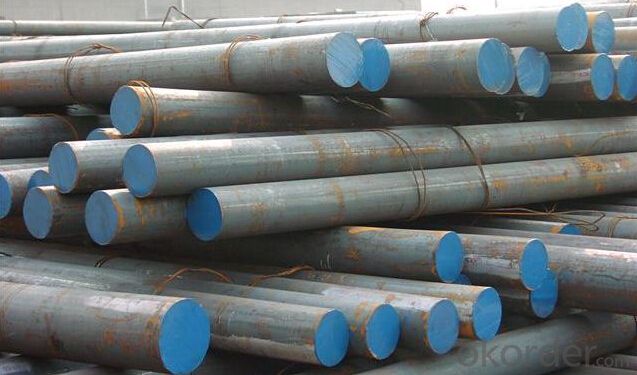
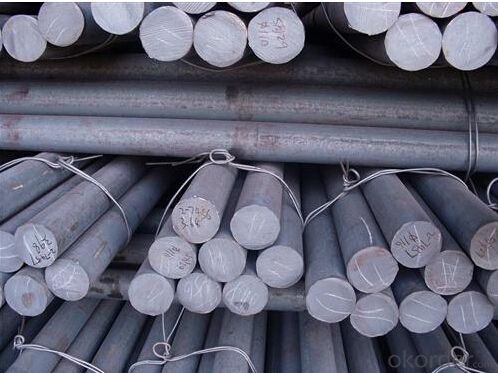
- Q: What are the advantages of using special steel in manufacturing?
- Special steel in manufacturing offers several advantages. Firstly, it provides a higher level of strength and durability compared to regular steel. This is because of the presence of alloying elements, like chromium, nickel, and manganese, which enhance its mechanical properties. As a result, special steel can withstand heavy loads, resist wear and tear, and endure extreme conditions, making it ideal for manufacturing applications requiring strength and longevity. Secondly, special steel exhibits excellent corrosion resistance. The addition of elements like chromium forms a protective oxide layer on the steel's surface, preventing rusting and corrosion when exposed to moisture or harsh environments. This corrosion resistance is crucial in industries such as marine, automotive, and construction, where materials face constant exposure to water, salt, and chemicals. Furthermore, special steel possesses exceptional heat resistance and heat transfer properties. These properties are vital in manufacturing processes involving high temperatures, such as forging, casting, and heat treatment. Special steel retains its strength and structural integrity even at elevated temperatures, enabling the production of components capable of withstanding extreme heat conditions. Another advantage of using special steel in manufacturing is its versatility. It can be easily customized and tailored to specific requirements. Manufacturers can modify it to exhibit various mechanical properties, including hardness, toughness, or flexibility, depending on the application. This flexibility allows for the development of components with precise characteristics, ensuring optimal performance and efficiency. Lastly, special steel proves to be more cost-effective in the long run. Although initial costs may be higher than regular steel, its superior durability and longevity result in reduced maintenance and replacement costs. Additionally, the enhanced properties of special steel can lead to improved energy efficiency and reduced material waste, contributing to overall cost savings in the manufacturing process. In conclusion, the utilization of special steel in manufacturing brings forth benefits such as increased strength and durability, excellent corrosion resistance, superior heat resistance, versatility, and long-term cost-effectiveness. These advantages make it the preferred choice for various industries, guaranteeing the production of high-quality and reliable components.
- Q: What are the common quality control measures for special steel?
- Common quality control measures for special steel include: 1. Chemical Composition Analysis: Special steel often requires specific chemical compositions to meet the desired properties. Quality control measures involve analyzing the chemical composition through techniques like spectrometry to ensure it meets the required specifications. 2. Mechanical Testing: Special steel needs to possess specific mechanical properties such as strength, hardness, toughness, and ductility. Quality control measures involve conducting mechanical tests like tensile testing, hardness testing, impact testing, and fatigue testing to ensure the steel meets the required standards. 3. Non-Destructive Testing: Non-destructive testing methods like ultrasonic testing, magnetic particle testing, and dye penetrant testing are employed to detect any internal or surface defects in the steel. These tests help ensure the integrity and reliability of the special steel. 4. Dimensional Inspection: Special steel often requires precise dimensions for its intended application. Dimensional inspection involves measuring the length, width, thickness, diameter, and other critical dimensions to ensure they meet the required tolerances specified by the customer or industry standards. 5. Surface Quality Inspection: Special steel may require specific surface finishes or coatings to enhance its performance or resistance to corrosion. Quality control measures involve inspecting the steel surface for defects such as cracks, pits, scratches, or unevenness to ensure it meets the required surface quality standards. 6. Heat Treatment Verification: Special steel often undergoes heat treatment processes like annealing, quenching, or tempering to achieve the desired mechanical properties. Quality control measures involve verifying the effectiveness of the heat treatment process through hardness testing or microstructure analysis. 7. Documentation and Traceability: Quality control measures also involve maintaining comprehensive documentation and traceability records of the special steel, including details of its production process, chemical composition, mechanical properties, and any inspections or tests performed. This helps ensure quality consistency and provides a reference for future use or troubleshooting. By implementing these quality control measures, manufacturers can ensure that special steel meets the required specifications, providing customers with high-quality and reliable products for their specific applications.
- Q: How does special steel contribute to reducing product recalls?
- Special steel contributes to reducing product recalls by offering enhanced strength, durability, and corrosion resistance, thereby ensuring the integrity and reliability of various products. This reduces the likelihood of manufacturing defects, material failures, and premature breakdowns, which are common causes of product recalls. By using special steel in critical components, manufacturers can enhance product performance, safety, and longevity, leading to fewer recalls and improved customer satisfaction.
- Q: How does special steel contribute to reducing product lead times?
- Special steel contributes to reducing product lead times by offering enhanced material properties and performance characteristics. It allows manufacturers to achieve higher machining speeds and feeds, resulting in faster production processes. Special steel also exhibits excellent dimensional stability, reducing the need for post-processing and time-consuming adjustments. Moreover, its exceptional strength and durability enable the design of lighter and more efficient components, which can expedite assembly and reduce overall manufacturing time. By utilizing special steel, companies can streamline their production operations, increase productivity, and ultimately shorten product lead times.
- Q: How is special steel used in the construction supply chain?
- Special steel is used in various ways in the construction supply chain. It is commonly used in the production of high-quality tools and equipment used in construction, such as drills, saws, and hammers. Special steel is also utilized in the manufacturing of structural components, such as beams and columns, which provide strength and durability to buildings and infrastructure projects. Additionally, it is used in the production of reinforcing bars and wire mesh, which reinforce concrete structures and ensure their stability. Overall, special steel plays a crucial role in enhancing the performance and safety of construction materials and products in the supply chain.
- Q: What are the requirements for special steel used in high-performance racing cars?
- The requirements for special steel used in high-performance racing cars include high strength and durability, excellent fatigue resistance, good thermal conductivity, and the ability to withstand high temperatures and extreme conditions. Additionally, it should have low weight and high stiffness to enhance the car's performance and maintain its structural integrity under intense stress and vibration.
- Q: How does corrosion-resistant steel protect against chemical attacks?
- Corrosion-resistant steel protects against chemical attacks by forming a protective layer on its surface, which acts as a barrier between the steel and the corrosive substances. This layer, typically composed of chromium oxide, is highly stable and prevents the steel from direct contact with chemicals, thus reducing the likelihood of corrosion.
- Q: How does quenching and tempering affect the hardness of special steel?
- Quenching and tempering significantly impact the hardness of special steel. Quenching involves rapidly cooling the steel from a high temperature, which results in a hard and brittle structure. On the other hand, tempering involves reheating the quenched steel to a specific temperature and then cooling it slowly, which reduces the brittleness and increases the toughness of the steel while maintaining a desired level of hardness. Overall, this heat treatment process modifies the microstructure of the steel, leading to a controlled increase in hardness while improving its mechanical properties.
- Q: What are the main challenges in welding special steel?
- The main challenges in welding special steel include its high carbon content, which can lead to cracking and distortion during the welding process. Additionally, special steels often have higher alloy content, making them prone to heat-affected zone (HAZ) issues such as reduced strength and corrosion resistance. Controlling the heat input and using suitable welding techniques and filler materials are crucial for successfully welding special steel.
- Q: What are the different methods of improving the toughness of special steel?
- There are several methods of improving the toughness of special steel. One common method is through heat treatment, such as quenching and tempering, which involves rapidly cooling the steel to increase its hardness and then reheating it to improve its toughness. Another method is alloying, where elements like nickel, chromium, and molybdenum are added to the steel to enhance its toughness. Additionally, refining the steel's microstructure through processes like grain-size control and precipitation hardening can also improve its toughness.
Send your message to us
Grade SAE1045 CNBM Carbon Steel Round Bar
- Loading Port:
- Shanghai
- Payment Terms:
- TT OR LC
- Min Order Qty:
- 3 m.t
- Supply Capability:
- 10000 m.t/month
OKorder Service Pledge
OKorder Financial Service
Similar products
Hot products
Hot Searches
Related keywords
